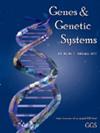{"title":"小鼠成熟精子细胞产生的调控机制。","authors":"K. Ichiyanagi","doi":"10.1266/ggs.97.1","DOIUrl":null,"url":null,"abstract":"Copyright: ©2022 The Author(s). This is an open access article distributed under the terms of the Creative Commons BY 4.0 International (Attribution) License (https://creativecommons.org/ licenses/by/4.0/legalcode), which permits the unrestricted distribution, reproduction and use of the article provided the original source and authors are credited. In multicellular organisms that reproduce sexually, gametes are the sole type of cells that convey genetic information to the next generation. In mice, the germ cell lineage appears at the epiblast stage of embryogenesis, and is separated from the somatic lineage. The emerging germ cells are called primordial germ cells or PGCs, where methylation in the genomic DNA eventually becomes almost completely erased, transiently making their epigenome profoundly different from that of the somatic cells. Then, in sperm cell precursors called prospermatogonia in embryonic testes, de novo DNA methylation takes place genome-wide. These cells subsequently become spermatogonia with the stem cell activity to proliferate in response to external signals, which underlies the life-long production of spermatozoa. Spermatogonia are unipotent stem cells, and a fraction of them differentiate into spermatocytes, in which the transcriptomic program is switched to execute the special cell division process called meiosis. Meiosis in males produces haploid spermatids, which then differentiate into spermatozoa having specific morphology and highly condensed chromatin. All of these consecutive processes are orchestrated by a number of genes, and a failure in any of them results in infertility. In this issue, we have four review articles written by leading young scientists in mammalian germ cell biology. Kenjiro Shirane describes how DNA methylation The regulatory mechanisms that make mature sperm cells in the mouse","PeriodicalId":12690,"journal":{"name":"Genes & genetic systems","volume":"97 1 1","pages":"1"},"PeriodicalIF":1.0000,"publicationDate":"2022-02-01","publicationTypes":"Journal Article","fieldsOfStudy":null,"isOpenAccess":false,"openAccessPdf":"","citationCount":"0","resultStr":"{\"title\":\"The regulatory mechanisms that make mature sperm cells in the mouse.\",\"authors\":\"K. Ichiyanagi\",\"doi\":\"10.1266/ggs.97.1\",\"DOIUrl\":null,\"url\":null,\"abstract\":\"Copyright: ©2022 The Author(s). This is an open access article distributed under the terms of the Creative Commons BY 4.0 International (Attribution) License (https://creativecommons.org/ licenses/by/4.0/legalcode), which permits the unrestricted distribution, reproduction and use of the article provided the original source and authors are credited. In multicellular organisms that reproduce sexually, gametes are the sole type of cells that convey genetic information to the next generation. In mice, the germ cell lineage appears at the epiblast stage of embryogenesis, and is separated from the somatic lineage. The emerging germ cells are called primordial germ cells or PGCs, where methylation in the genomic DNA eventually becomes almost completely erased, transiently making their epigenome profoundly different from that of the somatic cells. Then, in sperm cell precursors called prospermatogonia in embryonic testes, de novo DNA methylation takes place genome-wide. These cells subsequently become spermatogonia with the stem cell activity to proliferate in response to external signals, which underlies the life-long production of spermatozoa. Spermatogonia are unipotent stem cells, and a fraction of them differentiate into spermatocytes, in which the transcriptomic program is switched to execute the special cell division process called meiosis. Meiosis in males produces haploid spermatids, which then differentiate into spermatozoa having specific morphology and highly condensed chromatin. All of these consecutive processes are orchestrated by a number of genes, and a failure in any of them results in infertility. In this issue, we have four review articles written by leading young scientists in mammalian germ cell biology. Kenjiro Shirane describes how DNA methylation The regulatory mechanisms that make mature sperm cells in the mouse\",\"PeriodicalId\":12690,\"journal\":{\"name\":\"Genes & genetic systems\",\"volume\":\"97 1 1\",\"pages\":\"1\"},\"PeriodicalIF\":1.0000,\"publicationDate\":\"2022-02-01\",\"publicationTypes\":\"Journal Article\",\"fieldsOfStudy\":null,\"isOpenAccess\":false,\"openAccessPdf\":\"\",\"citationCount\":\"0\",\"resultStr\":null,\"platform\":\"Semanticscholar\",\"paperid\":null,\"PeriodicalName\":\"Genes & genetic systems\",\"FirstCategoryId\":\"99\",\"ListUrlMain\":\"https://doi.org/10.1266/ggs.97.1\",\"RegionNum\":4,\"RegionCategory\":\"生物学\",\"ArticlePicture\":[],\"TitleCN\":null,\"AbstractTextCN\":null,\"PMCID\":null,\"EPubDate\":\"\",\"PubModel\":\"\",\"JCR\":\"Q4\",\"JCRName\":\"BIOCHEMISTRY & MOLECULAR BIOLOGY\",\"Score\":null,\"Total\":0}","platform":"Semanticscholar","paperid":null,"PeriodicalName":"Genes & genetic systems","FirstCategoryId":"99","ListUrlMain":"https://doi.org/10.1266/ggs.97.1","RegionNum":4,"RegionCategory":"生物学","ArticlePicture":[],"TitleCN":null,"AbstractTextCN":null,"PMCID":null,"EPubDate":"","PubModel":"","JCR":"Q4","JCRName":"BIOCHEMISTRY & MOLECULAR BIOLOGY","Score":null,"Total":0}
引用次数: 0
The regulatory mechanisms that make mature sperm cells in the mouse.
Copyright: ©2022 The Author(s). This is an open access article distributed under the terms of the Creative Commons BY 4.0 International (Attribution) License (https://creativecommons.org/ licenses/by/4.0/legalcode), which permits the unrestricted distribution, reproduction and use of the article provided the original source and authors are credited. In multicellular organisms that reproduce sexually, gametes are the sole type of cells that convey genetic information to the next generation. In mice, the germ cell lineage appears at the epiblast stage of embryogenesis, and is separated from the somatic lineage. The emerging germ cells are called primordial germ cells or PGCs, where methylation in the genomic DNA eventually becomes almost completely erased, transiently making their epigenome profoundly different from that of the somatic cells. Then, in sperm cell precursors called prospermatogonia in embryonic testes, de novo DNA methylation takes place genome-wide. These cells subsequently become spermatogonia with the stem cell activity to proliferate in response to external signals, which underlies the life-long production of spermatozoa. Spermatogonia are unipotent stem cells, and a fraction of them differentiate into spermatocytes, in which the transcriptomic program is switched to execute the special cell division process called meiosis. Meiosis in males produces haploid spermatids, which then differentiate into spermatozoa having specific morphology and highly condensed chromatin. All of these consecutive processes are orchestrated by a number of genes, and a failure in any of them results in infertility. In this issue, we have four review articles written by leading young scientists in mammalian germ cell biology. Kenjiro Shirane describes how DNA methylation The regulatory mechanisms that make mature sperm cells in the mouse


